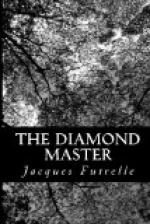“Das iss!” declared the German bluntly. “Id vas coming in dime, Laadham, id vas coming, of course Und I haf always noticed dat whatever iss coming does come.”
“Made, made—made as you make marbles,” Mr. Czenki repeated monotonously. “Yes, it had to come, but—but imagine the insuperable difficulties that one brain had to surmount!” He passed a thin hand across his flushed brow, and was thoughtfully silent.
“I don’t believe it,” asserted Mr. Latham tartly. “It’s impossible! I don’t believe it!” And sat down.
“Id don’d madder much whedher you belief id or nod,” remarked the German in a tone of resignation. “If id iss, id iss. Und all dose diamonds in your place und mine are nod worth much more by der bushel as potatoes.”
Mr. Latham turned away from him, half angrily, and glared at the expert, who was still regarding the floor.
“What do you know about this, anyway, Czenki?” he demanded. “How do you know he makes them? Have you seen him make them?”
Thus directly addressed Mr. Czenki looked up, and the living flame of wonder within his eyes flickered and died. In silence, for a minute or more, he studied the unconcealed skepticism in his employer’s face, and then asked slowly:
“Do you know what diamonds are, Mr. Latham?”
“There is some theory that they are pure carbon, crystallized.”
“They are that,” declared the expert impatiently. “You know that diamonds have been made?”
“Oh, I’ve read something about it, yes; but what I—”
“Every school-boy knows how to make a diamond, Mr. Latham. If pure carbon is heated to approximately five thousand degrees Fahrenheit, and simultaneously subjected to a pressure of approximately six thousand tons to the square inch, it becomes a diamond. And there’s no theory about that—that’s a fact! The difficulty has always been to apply the knowledge we have in a commercially practicable way—in other words, to isolate a carbon that is absolutely pure, and invent a method of applying the heat and pressure simultaneously. It has been done, Mr. Latham; it has been done! Don’t you understand what it means to—”
With an effort he repressed the returning excitement which found vent in a rising voice and quick, nervous gestures of the hands. After a moment he went on:
“Half a score of scientists have made diamonds, minute particles no larger than the point of a pin. Professor Henri Moissan, of Paris, went further, and by use of an electric furnace produced diamonds as large as a pinhead. You may remember that when I first met Mr. Wynne he inquired if I had not done some special work for Professor Moissan. I had; I tested the diamonds he made—and they were diamonds! I dare say the suggestion Mr. Wynne conveyed to me by that question—that is, the suggestion of manufactured diamonds—had been carefully planned, for he is a wonderful young man, Mr. Wynne— a wonderful young man.” He paused a moment. “We know that he has millions and millions of dollars’ worth of them—we know because we saw them—and who can tell how many billions more there are? The one man holds in his hand the power to overturn the money values of the earth!”




